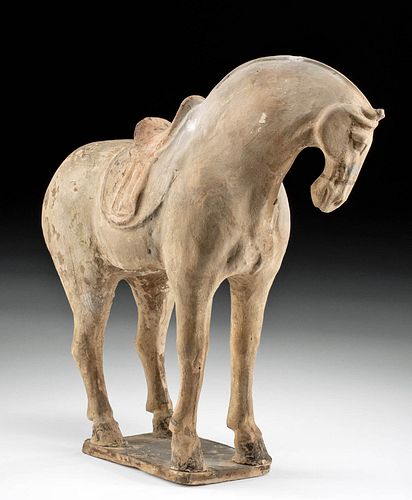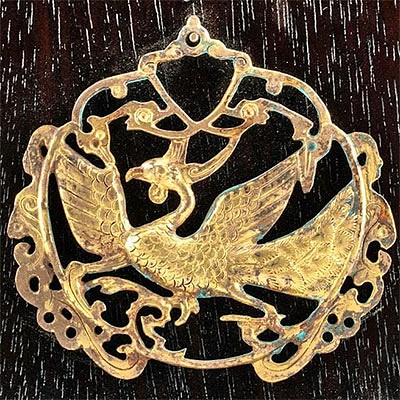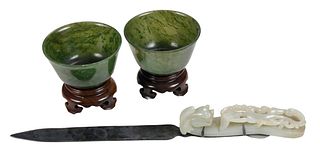Fine Chinese Tang Dynasty Pottery Horse
Lot 108
About Seller
Artemis Gallery
686 S Taylor Ave, Ste 106
Louisville, CO 80027
United States
Selling antiquities, ancient and ethnographic art online since 1993, Artemis Gallery specializes in Classical Antiquities (Egyptian, Greek, Roman, Near Eastern), Asian, Pre-Columbian, African / Tribal / Oceanographic art. Our extensive inventory includes pottery, stone, metal, wood, glass and textil...Read more
Categories
Estimate:
$2,500 - $3,500
Absentee vs Live bid
Two ways to bid:
- Leave a max absentee bid and the platform will bid on your behalf up to your maximum bid during the live auction.
- Bid live during the auction and your bids will be submitted real-time to the auctioneer.
Bid Increments
| Price | Bid Increment |
|---|---|
| $0 | $25 |
| $300 | $50 |
| $1,000 | $100 |
| $2,000 | $250 |
| $5,000 | $500 |
| $10,000 | $1,000 |
| $20,000 | $2,500 |
| $50,000 | $5,000 |
| $100,000 | $10,000 |
| $200,000 | $20,000 |
About Auction
By Artemis Gallery
Jun 17, 2021
Set Reminder
2021-06-17 10:00:00
2021-06-17 10:00:00
America/New_York
Bidsquare
Bidsquare : Ancient & Ethnographic Art Through The Ages
https://www.bidsquare.com/auctions/artemis-gallery/ancient-ethnographic-art-through-the-ages-7094
Ancient art from Egypt, Greece, Italy and the Near East, as well as Asian, Fossils, Pre-Columbian, Native American, African / Tribal / Oceanic, Fine art, and much more! All categories, all price ranges... all legally acquired and guaranteed to be as described or your money back. Artemis Gallery info@artemisgallery.com
Ancient art from Egypt, Greece, Italy and the Near East, as well as Asian, Fossils, Pre-Columbian, Native American, African / Tribal / Oceanic, Fine art, and much more! All categories, all price ranges... all legally acquired and guaranteed to be as described or your money back. Artemis Gallery info@artemisgallery.com
- Lot Description
East Asia, China, Tang Dynasty, ca. 618 to 906 CE. A fine mold-made pottery horse, depicted standing atop a rectangular plinth with its head bent downwards, turned ever so slightly to the left. Adorned in hues of red, black, brown, and cream, the ancient animal features a well-manicured mane and a thick body with a sizeable saddle placed upon its back. Its naturalistic head is strapped in reins and displays a long snout, naturalistic eyes, and perky ears. A petite tail hangs from its posterior. A horse effigy like one would accompany tomb attendants known as mingqi, "spirit utensils" or "vessels for ghosts". They became popular in the Han Dynasty and would persist for several centuries. In addition to animals, there were musicians, athletes, architectural structures, and more. These were designed to assist the po, the part of the soul of the deceased that remained underground with the body while the hun, the other part of the soul, ascended. Size: 9.5" L x 4.5" W x 11" H (24.1 cm x 11.4 cm x 27.9 cm)
According to Zhixin Jason Sun, Curator of the Department of Asian Art at the Metropolitan Museum of Art, "The importance of horses rose to new heights in the Tang dynasty (618–907) when, as emblems of imperial power, they marched in state processions, galloped through royal hunting parks, raced across polo fields, and even danced before the emperor. Their portraits were painted by leading court artists, and their majestic form was modeled in brightly glazed pottery as tomb figurines and sculpted on marble plaques to adorn emperors' tombs as symbols of dynastic vitality." Beyond this, the horse played a significant role in the unification of the Chinese Empire, as the ancients could communicate to parties near and far due to the great speed of these noble steeds. The horse also assisted the military to conquer distant lands and grow the empire. As the desire for stronger, faster breeds grew, the ancients imported horses from Central Asia, leading to the creation of the famous Silk Road.
We see evidence of the reverence for the horse in the visual culture of ancient China. Imagery of horses abound in painting, literature, and sculpture. During the Tang dynasty, artists created burial art representing these revered animals. This particular piece depicts a large charger; this type of horse served as both a symbol of imperial stability that engendered bountiful trade and prosperity for the expanding empire and the reward of military exploits to the west. The most cherished horses were raised in the western kingdom of Ferghana and known as "blood-sweating horses." These were delivered as tribute to the reigning emperor. In general, for the ancient Chinese, horses were a sign of wealth.
Provenance: private New Jersey, USA collection, purchased ca. 2015; ex-Georgia, USA collection; ex-Los Angeles collection, California, USA
All items legal to buy/sell under U.S. Statute covering cultural patrimony Code 2600, CHAPTER 14, and are guaranteed to be as described or your money back.
A Certificate of Authenticity will accompany all winning bids.
We ship worldwide and handle all shipping in-house for your convenience.
#164484Repaired from a few large pieces with restoration over break lines. Chipping to tips of ears and base. Nick to mane. Expected light abrasions, commensurate with age. Otherwise, excellent with nice remaining pigments.Condition
- Shipping Info
-
All shipping is handled in-house for your convenience. Your invoice from Artemis Gallery will include shipping calculation instructions. If in doubt, please inquire BEFORE bidding for estimated shipping costs for individual items.
-
- Buyer's Premium



 EUR
EUR CAD
CAD AUD
AUD GBP
GBP MXN
MXN HKD
HKD CNY
CNY MYR
MYR SEK
SEK SGD
SGD CHF
CHF THB
THB














